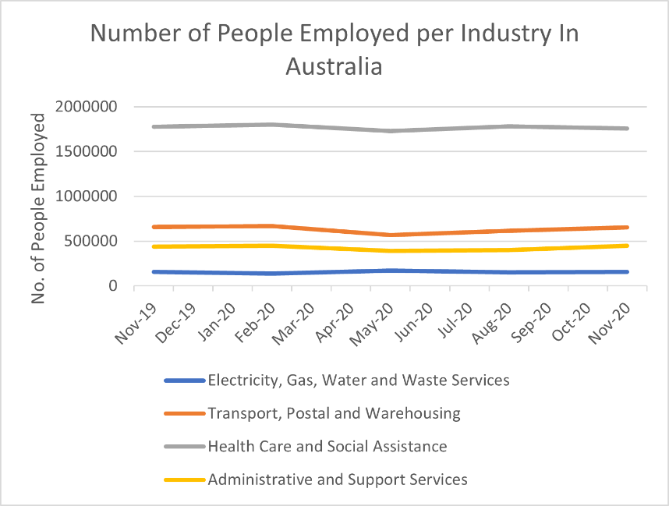Does job growth suggest a new job boom or a re-hiring boom?
Is the Australian workforce recovering to pre-pandemic levels? Is it doing better? Or have the dynamics changed? When the pandemic hit, most industries suffered; meanwhile, others grew significantly to support the new needs of consumers. As we adjust to life in the new ‘covid-normal’, will we see things go back to ‘pre-covid’ normal or has…
Is the Australian workforce recovering to pre-pandemic levels? Is it doing better? Or have the dynamics changed?
When the pandemic hit, most industries suffered; meanwhile, others grew significantly to support the new needs of consumers. As we adjust to life in the new ‘covid-normal’, will we see things go back to ‘pre-covid’ normal or has the economy evolved?
While many say we have come to see a job boom in Australia, the question we ask is, is it really a job boom or are businesses just rehiring to fill the roles which they had dropped when the pandemic hit?
Here’s what we’ve found.
Unemployment and the increase of trading businesses
It’s no secret that when the pandemic hit and was approaching its peak, many were stood down or lost their jobs completely. In November 2019, 1.13 million people were unemployed in Australia. In May 2020, 1.69 million people were unemployed and at the end of the year, in November 2020, the number decreased to 1.29 unemployed people. While this suggests that many people have been re-employed, whether jobs have been refilled or new jobs were created remains unclear.
One economist suggests that jobs that were lost due to the pandemic have been completely replaced. Although, there is speculation that there may be changes, again, in the labour market when the JobKeeper scheme expires at the end of this month.
Interestingly, at the same time that unemployment increased, so did the number of businesses that began trading in the Australian economy. In 2019-2020, the percentage of businesses trading in the Australian economy increased by 2%. We can assume that new roles were created which did not exist before the pandemic, but we need more data to be sure.
Shifts throughout the pandemic
As consumer needs shifted during the pandemic, relevant industries grew to meet those demands. People were forced to start working from home, hospitals grew busier, and more people started shopping online.
Industries with significant increases in operating businesses included utility services (2.5%), transport, postal and warehousing services (5.5%), health care and social assistance services (5%), and administrative and support services (4.5%) as of June 2020.
Fast forward to November 2020, data suggests that not much has changed in these industries. While there were changes to these industries during the pandemic, nearing the end, the number of people employed in each industry began to revert to pre-pandemic levels. This suggests that the new roles which were created to meet those demands may have only been temporary.
The following graph and table show the number of people employed per industry, from November 2019 to November 2020.

Figure 1 Source: Australian Bureau of Statistics
Figure 2 Source: Australian Bureau of Statistics
The number of people employed in each industry only changed by 1% from November 2019 to November 2020, with the biggest difference being a 3% increase in the number of people employed in Administrative and Support Services.
What can we conclude?
The data suggests that we have refilled the roles which were lost due to the pandemic. We are well on track to recovering to pre-pandemic levels.
But why should businesses stop there? If Australian businesses are to survive and do better than pre-pandemic levels, their operations need to change. While the workforce seems to be only somewhat different to pre-pandemic levels, what has changed is the way in which people behave.
What needs to change for the economy to grow?
COVID-19 brought changes that are likely to stick around long after its departure. Businesses should consider these changes in how they affect their workforce and the demands of their consumers.
Many who worked from home during the pandemic would prefer to continue working from home completely or at least for a portion of the workweek. Employers should consider being open to flexible working arrangements, so they don’t lose against competitors when trying to retain and attract talent. The McKinsey Global Institute estimates that more than 20% of the global workforce could work away from the office and be just as effective. For businesses that have roles where employees can’t work from home, we have made a number of suggestions to take into the post-pandemic world.
Businesses need to also consider the wants and needs of their consumers. As the world became to rely on technology, consumers began to expect that businesses offer more digital services. Some of these changes include an increase in:
- Online shopping
- Telephone consultations used by those requiring health care services
- Remote learning
- Online entertainment streaming
With these changes, business operations should be reassessed to ensure they are compatible with a post-COVID world. For example, with more people working from home, businesses need to ensure measures are in place to protect their data and that they have the infrastructure in place for their employees to work from home effectively.
If you’d like deeper insights into the talent market in your industry, fill out the form on this page and we’ll be in touch with a report that’s tailored to your needs.







